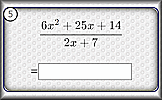Here are some specific activities, investigations or visual aids we have picked out. Click anywhere in the grey area to access the resource.
Here is an exam-style questions on this statement:
Click on a topic below for suggested lesson Starters, resources and activities from Transum.
Furthermore
The factor theorem and remainder theorem are fundamental concepts in polynomial algebra. The factor theorem states that for a polynomial \( P(x) \), if \( P(a) = 0 \), then \( (x-a) \) is a factor of \( P(x) \). The remainder theorem, on the other hand, states that when a polynomial \( P(x) \) is divided by a linear divisor \( x-a \), the remainder is \( P(a) \).
Key Formulae:
$$ P(a) = 0 \implies (x-a) \text{ is a factor of } P(x) $$ $$ \text{Remainder of } P(x) \text{ when divided by } (x-a) = P(a) $$Example:
Consider the polynomial \( P(x) = x^2 - 3x + 2 \). Using the factor theorem, if \( P(1) = 0 \), then \( (x-1) \) is a factor of \( P(x) \).
$$ P(1) = 1^2 - 3(1) + 2 = 0 $$Thus, \( (x-1) \) is a factor of \( P(x) \). Additionally, using the remainder theorem, the remainder when \( P(x) \) is divided by \( x-1 \) is \( P(1) \), which is 0 in this case.
How do you teach this topic? Do you have any tips or suggestions for other teachers? It is always useful to receive feedback and helps make these free resources even more useful for Maths teachers anywhere in the world. Click here to enter your comments.


